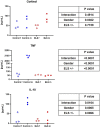Porcine blood cell and brain tissue energy metabolism: Effects of "early life stress"
- PMID: 37138659
- PMCID: PMC10150084
- DOI: 10.3389/fmolb.2023.1113570
Porcine blood cell and brain tissue energy metabolism: Effects of "early life stress"
Abstract
Background: Early Life Stress (ELS) may exert long-lasting biological effects, e.g., on PBMC energy metabolism and mitochondrial respiration. Data on its effect on brain tissue mitochondrial respiration is scarce, and it is unclear whether blood cell mitochondrial activity mirrors that of brain tissue. This study investigated blood immune cell and brain tissue mitochondrial respiratory activity in a porcine ELS model. Methods: This prospective randomized, controlled, animal investigation comprised 12 German Large White swine of either sex, which were weaned at PND (postnatal day) 28-35 (control) or PND21 (ELS). At 20-24 weeks, animals were anesthetized, mechanically ventilated and surgically instrumented. We determined serum hormone, cytokine, and "brain injury marker" levels, superoxide anion (O2 •¯) formation and mitochondrial respiration in isolated immune cells and immediate post mortem frontal cortex brain tissue. Results: ELS animals presented with higher glucose levels, lower mean arterial pressure. Most determined serum factors did not differ. In male controls, TNFα and IL-10 levels were both higher than in female controls as well as, no matter the gender in ELS animals. MAP-2, GFAP, and NSE were also higher in male controls than in the other three groups. Neither PBMC routine respiration and brain tissue oxidative phosphorylation nor maximal electron transfer capacity in the uncoupled state (ETC) showed any difference between ELS and controls. There was no significant relation between brain tissue and PBMC, ETC, or brain tissue, ETC, and PBMC bioenergetic health index. Whole blood O2 •¯ concentrations and PBMC O2 •¯ production were comparable between groups. However, granulocyte O2 •¯ production after stimulation with E. coli was lower in the ELS group, and this effect was sex-specific: increased O2 •¯ production increased upon stimulation in all control animals, which was abolished in the female ELS swine. Conclusion: This study provides evidence that ELS i) may, gender-specifically, affect the immune response to general anesthesia as well as O2 •¯ radical production at sexual maturity, ii) has limited effects on brain and peripheral blood immune cell mitochondrial respiratory activity, and iii) mitochondrial respiratory activity of peripheral blood immune cells and brain tissue do not correlate.
Keywords: PBMC; electron spin resonance; granulocyte; high resolution respirometry; mitochondrial respiration; superoxide anion.
Copyright © 2023 Münz, Wolfschmitt, Zink, Abele, Hogg, Hoffmann, Gröger, Calzia, Waller, Radermacher and Merz.
Conflict of interest statement
The authors declare that the research was conducted in the absence of any commercial or financial relationships that could be construed as a potential conflict of interest.
Figures




Similar articles
-
Relation of Plasma Catecholamine Concentrations and Myocardial Mitochondrial Respiratory Activity in Anesthetized and Mechanically Ventilated, Cardiovascular Healthy Swine.Int J Mol Sci. 2023 Dec 9;24(24):17293. doi: 10.3390/ijms242417293. Int J Mol Sci. 2023. PMID: 38139121 Free PMC article.
-
The effect of sodium thiosulfate on immune cell metabolism during porcine hemorrhage and resuscitation.Front Immunol. 2023 Feb 23;14:1125594. doi: 10.3389/fimmu.2023.1125594. eCollection 2023. Front Immunol. 2023. PMID: 36911662 Free PMC article.
-
Mitochondrial bioenergetic alterations after focal traumatic brain injury in the immature brain.Exp Neurol. 2015 Sep;271:136-44. doi: 10.1016/j.expneurol.2015.05.009. Epub 2015 May 28. Exp Neurol. 2015. PMID: 26028309 Free PMC article.
-
Neuroimmune Impacts of Early-Life Stress on Development and Psychopathology.Curr Top Behav Neurosci. 2019;43:423-447. doi: 10.1007/7854_2018_53. Curr Top Behav Neurosci. 2019. PMID: 30003509 Review.
-
The Effects of Early Life Stress on the Brain and Behaviour: Insights From Zebrafish Models.Front Cell Dev Biol. 2021 Jul 21;9:657591. doi: 10.3389/fcell.2021.657591. eCollection 2021. Front Cell Dev Biol. 2021. PMID: 34368117 Free PMC article. Review.
Cited by
-
Bayesian 13C-Metabolic Flux Analysis of Parallel Tracer Experiments in Granulocytes: A Directional Shift within the Non-Oxidative Pentose Phosphate Pathway Supports Phagocytosis.Metabolites. 2023 Dec 29;14(1):24. doi: 10.3390/metabo14010024. Metabolites. 2023. PMID: 38248827 Free PMC article.
-
Ex Vivo 13C-Metabolic Flux Analysis of Porcine Circulating Immune Cells Reveals Cell Type-Specific Metabolic Patterns and Sex Differences in the Pentose Phosphate Pathway.Biomolecules. 2024 Jan 12;14(1):98. doi: 10.3390/biom14010098. Biomolecules. 2024. PMID: 38254698 Free PMC article.
-
Relation of Plasma Catecholamine Concentrations and Myocardial Mitochondrial Respiratory Activity in Anesthetized and Mechanically Ventilated, Cardiovascular Healthy Swine.Int J Mol Sci. 2023 Dec 9;24(24):17293. doi: 10.3390/ijms242417293. Int J Mol Sci. 2023. PMID: 38139121 Free PMC article.
-
13C-Metabolic flux analysis detected a hyperoxemia-induced reduction of tricarboxylic acid cycle metabolism in granulocytes during two models of porcine acute subdural hematoma and hemorrhagic shock.Front Immunol. 2024 Jan 9;14:1319986. doi: 10.3389/fimmu.2023.1319986. eCollection 2023. Front Immunol. 2024. PMID: 38332911 Free PMC article.
References
-
- Amini-Khoei H., Mohammadi-Asl A., Amiri S., Hosseini M. J., Momeny M., Hassanipour M., et al. (2017). Oxytocin mitigated the depressive-like behaviors of maternal separation stress through modulating mitochondrial function and neuroinflammation. Prog. Neuropsychopharmacol. Biol. Psychiatry 76, 169–178. 10.1016/j.pnpbp.2017.02.022 - DOI - PubMed
-
- Boeck C., Gumpp A. M., Calzia E., Radermacher P., Waller C., Karabatsiakis A., et al. (2018). The association between cortisol, oxytocin, and immune cell mitochondrial oxygen consumption in postpartum women with childhood maltreatment. Psychoneuroendocrinology 96, 69–77. 10.1016/j.psyneuen.2018.05.040 - DOI - PubMed
LinkOut - more resources
Full Text Sources
Miscellaneous

